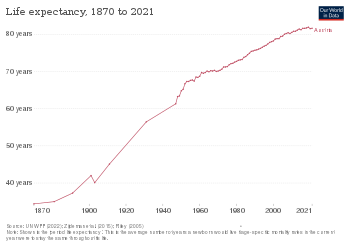
Back الرعاية الصحية في النمسا Arabic Avstriyada səhiyyə Azerbaijani Gesundheitssystem in Österreich German Salud en Austria Spanish Здравоохранение в Австрии Russian Охорона здоров'я в Австрії Ukrainian

The nation of Austria has a two-tier health care system in which virtually all individuals receive publicly funded care, but they also have the option to purchase supplementary private health insurance. Care involving private insurance plans (sometimes referred to as "comfort class" care) can include more flexible visiting hours and private rooms and doctors.[1] Some individuals choose to completely pay for their care privately.[1]

Healthcare in Austria is universal for residents of Austria as well as those from other EU countries.[2] Students from an EU/EEA country or Switzerland with national health insurance in their home country can use the European Health Insurance Card.[3] Self-insured students have to pay an insurance fee of EUR 52.68 per month.[3]
Enrollment in the public health care system is generally automatic and is linked to employment,[4] however insurance is also guaranteed to co-insured persons (i.e. spouses and dependants[5] ), pensioners, students, the disabled, and those receiving unemployment benefits.[5] Enrollment is compulsory, and it is not possible to cross-shop the various social security institutions.[4] Employers register their employees with the correct institution and deduct the health insurance tax from employees' salaries.[6] Some people, such as the self-employed, are not automatically enrolled but are eligible to enroll in the public health insurance scheme.[4] The cost of public insurance is based on income and is not related to individual medical history or risk factors.[6]
All insured persons are issued an e-Card, which must be presented when visiting a doctor (however some doctors only treat privately insured patients). The e-Card allows for the digitization of health claims and replaces the earlier health insurance voucher.[7] Additionally the e-Card can be used for electronic signatures.[8] E-Cards issued after October 2019 will also contain a photo of the card owner to prevent fraud.[9]
Hospitals and clinics can be either state-run or privately run.[4] Austria has a relatively high density of hospitals and physicians; In 2011 there were 4.7 Physicians per 1000 people, which is slightly greater than the average for Europe.[4] In-patient care is emphasized within the Austrian healthcare system; Austria has the most acute care discharges per 100 inhabitants in Europe and the average hospital stay is 6.6 days compared with an EU average of 6.[4]
By 2008 the economic crisis caused a deep recession, and out-of-pocket payments for healthcare increased to become 28% of health expenditures.[10] By 2010, Austria's public spending has decreased overall, but it was 15.5%, compared to 13.9% fifteen years earlier.[11]
- ^ a b Bondi, Susie (September 2009). "Austrian Health Care". Association of Americans Resident Overseas. Retrieved April 2, 2011.
- ^ The Austrian healthcare system Overview of how it works Accessed: 16 October 2011.
- ^ a b Austrian agency for international mobility and cooperation in education, science and research: National health insurance Archived 2014-12-29 at the Wayback Machine Retrieved: June 26, 2014.
- ^ a b c d e f "The Austrian Healthcare System: Key Facts" (PDF). Bundesministerium für Gesundheit. Archived from the original (PDF) on 11 July 2019. Retrieved 5 May 2018.
- ^ a b "Health Insurance". Stadt Wien. Retrieved 5 May 2018.
- ^ "Healthcare in Austria". Retrieved 5 May 2018.
- ^ "E-Card als Bürgerkarte". Digitales Österreich. Retrieved 5 May 2018.
- ^ "Pressegespräch - Jetzt kommt die e-cardmit Foto". Chipkarte.at. 2 October 2019.
- ^ "Expenditure on health care". European Foundation for the Improvement of Living and Working Conditions. 2011.
- ^ Hofmarcher, Maria M. (2013). Quentin, Wilm (ed.). "Austria: health system review" (PDF). Health Systems in Transition. 15 (7). Copenhagen, Denmark: World Health Organization: 75–134. PMID 24334772.
© MMXXIII Rich X Search. We shall prevail. All rights reserved. Rich X Search